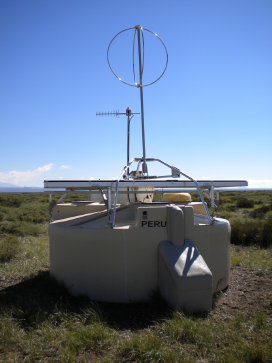
The station electronics is hidden underneath the dome visible on top of the WCD.
Operating since 2004, the Pierre Auger Observatory has led to major advances in our understanding of the ultra-high-energy cosmic rays (UHECR). The Observatory is located near Malargüe, Mendoza, Argentina. The surface detector (SD) array of the observatory consists of 1600 water-Cherenkov detectors (WCD) on a 1500 m triangular grid covering 3000 km². Another 60 WCDs, with a 750 m spacing, form a 27 km² in-fill region allowing extension to lower energies. The array is overlooked by four fluorescence detector (FD) sites each hosting 6 telescopes viewing a 180° azimuth by 30° elevation field of view. Three additional telescopes at one of the sites can be tilted 30° higher to view lower energy showers and overlook the infilled surface array.
In almost 20 years of operation, the Pierre Auger Observatory has provided, with unprecedented statistics and precision, major breakthroughs in the field of UHECRs. The steepening of their flux is now confirmed beyond any doubt as a succession of different power laws of energy. The primary mass composition is found to get heavier with increasing energy. A large-angular-scale anisotropy has been discovered above 8 × 10¹⁸ eV, proving that these UHECRs are of extragalactic origin, while anisotropies that mirror the distribution of nearby extragalactic matter have been evidenced at intermediate angular scales above ≃ 4 × 10¹⁹ eV.
The findings have revealed new insights that led to the upgrade of the Observatory, with the primary goal of obtaining information on the primary mass of the most energetic cosmic rays on a shower-by-shower basis. In the framework of the upgrade, called AugerPrime, the 1660 WCDs of the surface array are equipped with plastic scintillators (SSD) and radio antennas (RD), allowing us to enhance the composition sensitivity. The SSD and RD are mounted atop each WCD detector as can be seen in the figure. The WCD dynamic range is increased to match that of SSD by adding a small PMT to read the signals of WCD. To accommodate new detectors and to increase experimental capabilities, the electronics is also upgraded. This includes better timing with up-to-date GPS receivers, higher sampling frequency, and more powerful local processing of the data.
The deployment of SSDs and electronics has now been completed and the RD deployment is currently already in progress. The test results as well as the commissioning studies show that the design meets the requirements. A final review of AugerPrime will take place in Malargüe in mid-November 2023.









